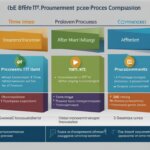Table of Contents
Welcome to our comprehensive guide on RFPs in the business world. In this article, we will explore what exactly an RFP is and how it plays a crucial role in procurement strategies and partnerships. Whether you’re new to the concept or looking to enhance your understanding, this guide will provide you with valuable insights and practical tips to navigate the RFP process successfully.
But first, let’s define what an RFP is. RFP stands for “Request for Proposal”. It is a formal document used by organizations to gather information from potential vendors or service providers. The RFP helps businesses make informed decisions by evaluating proposals from various vendors and selecting the one that best aligns with their requirements and objectives.
Procurement strategies are vital for organizations to optimize their purchasing decisions and foster successful partnerships. By utilizing the RFP process effectively, businesses can ensure a transparent, fair, and competitive evaluation of proposals, enabling them to select the right vendor and forge valuable partnerships that drive growth.
Throughout this guide, we will delve into the basics of RFPs, explore the stakeholders involved in the process, discuss the benefits of issuing an RFP, and outline the key steps involved in the RFP process. Additionally, we will share best practices to help you achieve a successful RFP process.
Whether you’re a business professional seeking to understand the intricacies of RFPs or a procurement specialist looking to enhance your existing knowledge, this guide will equip you with the necessary information to leverage the power of RFPs in your organization’s procurement strategies and partnerships.
So, let’s dive in and discover the world of RFPs in business!
RFP Basics
Before diving into the RFP process, it is crucial to understand the basics. An RFP, or request for proposal, is a formal document issued by an organization seeking to purchase a product or service. It serves as a standardized format for gathering vendor data, enabling easier comparisons in the evaluation process. The RFP process encompasses several steps including creation, administration, and evaluation. To better visualize the overall duration of the process, here is a sample RFP overview timeline:
| Phase | Duration |
|---|---|
| Creation and Approval | 2-4 weeks |
| Vendor Response Submission | 4-6 weeks |
| Evaluation and Shortlisting | 4-6 weeks |
| Vendor Presentations/Demonstrations | 2-4 weeks |
| Final Negotiation and Contract Signing | 2-4 weeks |
Understanding the RFP basics is key to navigating the process effectively and efficiently. The next section will delve into the crucial stakeholders involved in the RFP process and their respective roles.
Who is Involved in the RFP Process?
Various stakeholders play crucial roles in the RFP process. Let’s take a closer look at who these key players are:
Business Stakeholders
The RFP process begins with business stakeholders who initiate RFPs and guide the project from defining the need to scoring the results. They have a deep understanding of the organization’s goals and requirements, ensuring that the RFP aligns with the company’s strategic objectives.
Procurement Professionals
Procurement professionals are the backbone of the RFP process. They manage the entire process, vetting requests, facilitating the creation and distribution of RFPs, and working closely with vendors. These professionals ensure that the RFPs are well-structured, comprehensive, and effectively communicate the organization’s needs.
Consultants
In certain cases, organizations may hire consultants for their expertise in the RFP process. These consultants provide valuable insights, help in vendor selection, and advise on best practices. Their involvement ensures that the organization makes informed decisions while choosing the most suitable vendors.
Executives
Executives, including CFOs (Chief Financial Officers) and CPOs (Chief Procurement Officers), play a vital role in the RFP process. They provide final approval for high-value projects, ensuring alignment with the organization’s financial goals and strategic objectives. Their expertise and valuable input help in making critical decisions.
Vendors
Vendors are an essential part of the RFP process as they respond to the RFPs and showcase their offerings. Their participation and proposals allow organizations to evaluate different options, compare pricing, and assess the vendor’s capabilities. Vendors play a significant role in shaping the final outcome of the RFP process.
“The RFP process requires effective collaboration and communication among all stakeholders, from the business side to procurement professionals and vendors. This ensures a comprehensive evaluation of proposals, a fair selection process, and ultimately, the establishment of successful partnerships.”

| Stakeholder | Role |
|---|---|
| Business Stakeholders | Initiate RFPs, define project needs, and guide the process |
| Procurement Professionals | Manage the RFP process, vet requests, and work with vendors |
| Consultants | Provide expertise, assist in vendor selection |
| Executives (CFOs, CPOs) | Provide final approval for high-value projects |
| Vendors | Respond to RFPs and highlight their offerings |
Why Organizations Issue RFPs
Organizations issue Requests for Proposal (RFPs) for various reasons, as they offer numerous benefits and address complex considerations in the procurement process. By utilizing RFPs, businesses can gather vital information about potential vendors, evaluate competitive pricing, ensure a fair and unbiased process, and reduce risk.
Gathering Comprehensive Information
RFPs enable organizations to account for complex considerations by collecting extensive information about vendors. This includes their experience, financial stability, cultural fit, technical expertise, and more. By gathering comprehensive data, businesses can make well-informed decisions and select the most suitable vendors for their projects.
Creating a Competitive Pricing Environment
RFPs foster a competitive environment among vendors, encouraging them to provide the most competitive pricing options. When multiple vendors submit proposals, businesses can compare and negotiate pricing terms, leading to cost savings and increased value. This competitive process ensures that organizations receive the best possible pricing for their requirements.
Ensuring a Fair and Unbiased Process
RFPs establish a fair and unbiased process through data-driven evaluations and documentation. By defining evaluation criteria and scoring methods, organizations can objectively assess vendor proposals. This methodology ensures transparency, equity, and consistency in the evaluation process, enabling businesses to make impartial decisions based on merit.
Reducing Risk
RFPs help organizations mitigate risk by thoroughly vetting potential vendors. They verify critical aspects such as vendor diversity, sustainability practices, security policies, and compliance with regulations. Through rigorous evaluation, businesses can identify and select vendors that align with their risk management strategies, ensuring a more secure and reliable partnership.
Key Benefits of Issuing RFPs
| Benefit | Description |
|---|---|
| Comprehensive Vendor Evaluation | RFPs provide a structured approach to gather and assess vendor information, facilitating thorough evaluation and informed decision-making. |
| Evidence-Based Decision-Making | By utilizing data-driven evaluations, businesses can make decisions based on evidence and eliminate bias. |
| Cost Savings | Through a competitive pricing environment, organizations can negotiate better deals and achieve cost savings. |
| Increased Value | By selecting vendors through RFPs, businesses can ensure they receive optimal value for their investments. |
| Risk Mitigation | RFPs allow organizations to thoroughly assess vendor credentials, reducing the risk associated with partnerships. |
| Improved Supplier Diversity | By evaluating vendor diversity, organizations can promote inclusivity and broaden their supplier base. |
When to Issue an RFP
Issuing an RFP is essential for projects that require careful consideration and have a significant impact on the organization. RFPs should be utilized for strategic initiatives, high-value projects, and those with far-reaching consequences. In the realm of procurement, organizations often set a cost threshold as part of their policies, mandating the use of an RFP when the project expenditure meets or exceeds the threshold.
An RFP serves as a robust tool to assess potential vendors and secure the most suitable partnerships for the organization. By establishing transparent guidelines and evaluating vendors through a formal RFP process, organizational impact can be maximized while risks are mitigated.
When determining whether to issue an RFP, it is crucial to assess the project’s scope and potential benefits. Conducting a thorough evaluation ensures that the organization is making an informed decision about utilizing the RFP process.
Cost Threshold
Organizations commonly establish a cost threshold to determine when an RFP is necessary. This threshold serves as a financial benchmark and guides the decision-making process. If the project budget surpasses the cost threshold, initiating an RFP becomes mandatory. The cost threshold varies between organizations based on their budgetary constraints and procurement policies.
Strategic Projects
Strategic projects that align with the organization’s long-term goals often necessitate the use of an RFP. These projects have far-reaching implications and require meticulous vendor selection processes. By issuing an RFP, organizations can attract vendors who possess the specific skills, resources, and expertise required to successfully execute the project. This promotes alignment with the organization’s strategic objectives and ensures future success.
Organizational Impact
Projects with significant organizational impact, such as those related to critical infrastructure, major investments, or transformative initiatives, should involve an RFP process. These projects have wide-ranging effects on the organization’s operations, finances, and overall success. Utilizing an RFP enables the organization to evaluate vendors thoroughly, identify potential risks, and assess the impact on various aspects of the business.
| Project Type | Criteria for Issuing an RFP |
|---|---|
| High-Value Projects | Achieves or surpasses the organization’s pre-established cost threshold |
| Strategic Projects | Aligns with the organization’s long-term goals and requires specific expertise |
| Projects with Organizational Impact | Significantly impacts the organization’s operations, finances, or overall success |
By adhering to these guidelines and considering the project’s requirements and impact, organizations can make informed decisions regarding the necessity of issuing an RFP. This strategic approach helps ensure successful outcomes and fosters valuable partnerships.
The RFP Process Steps
The RFP process consists of three main steps – creation, administration, and evaluation. Each step plays a crucial role in ensuring a successful and efficient RFP process.
Creation
During the creation phase, stakeholders work together to define project needs and determine the scope of the RFP. This involves conducting thorough market research to identify potential vendors and gathering the necessary information to outline clear requirements.
Key activities in the creation phase include:
- Identifying the purpose and objectives of the RFP
- Conducting market analysis to assess vendor capabilities
- Defining project timelines and milestones
- Developing evaluation criteria to assess vendor proposals
Administration
The administration phase focuses on drafting and issuing the RFP to potential vendors. It’s vital to provide vendors with all the necessary information and clarification they need to submit comprehensive proposals.
Key activities in the administration phase include:
- Creating a clear and concise RFP document
- Setting transparent timelines for proposal submission
- Ensuring effective communication channels for vendor inquiries
- Reviewing and responding to vendor questions
Evaluation
The evaluation phase involves assessing and scoring vendor proposals based on predetermined criteria. Stakeholders compare and analyze the proposals to identify the best-fit vendors for the project.
Key activities in the evaluation phase include:
- Scoring and reviewing vendor proposals
- Shortlisting vendors based on the evaluation criteria
- Conducting demonstrations or meetings with shortlisted vendors
- Negotiating and finalizing contracts with the selected vendor(s)
The creation, administration, and evaluation steps form a systematic approach to ensure a well-structured and efficient RFP process. By following these steps, organizations can streamline their procurement processes, identify the most suitable vendors, and make informed decisions that drive successful projects.
Best Practices for a Successful RFP Process
Ensuring a successful RFP process requires adherence to best practices. Thorough planning, involving key stakeholders and establishing clear project requirements, is crucial. This sets a solid foundation for the entire process and ensures alignment between the organization’s needs and the vendor’s capabilities.
Transparency and accountability are vital for promoting a fair evaluation process. By providing clear guidelines and documentation, organizations can foster trust and demonstrate a commitment to impartiality. Additionally, maintaining open lines of communication with vendors throughout the process, responding to their queries promptly, fosters effective collaboration and builds strong relationships.
Effective communication is key to a successful RFP process, enabling smooth and efficient interactions. Organizations should establish clear channels for vendor questions and provide timely responses. Moreover, establishing concise evaluation criteria allows for a streamlined evaluation process, making it easier to compare and select the most suitable vendor.
Analyzing and learning from previous RFPs is another important practice. By conducting post-mortem reviews and identifying areas for improvement, organizations can refine their RFP process over time. Continuous improvement is essential for optimizing efficiency and enhancing the quality of vendor partnerships.
FAQ
What is an RFP in business?
An RFP, or request for proposal, is a formal document issued by an organization looking to purchase a product or service.
What are the RFP basics?
The RFP process consists of steps such as creation, administration, and evaluation. An RFP overview timeline can help visualize the overall duration of the process.
Who is involved in the RFP process?
Business stakeholders, procurement professionals, consultants, executives, and vendors all play crucial roles in the RFP process.
Why do organizations issue RFPs?
RFPs help account for complex considerations, encourage competitive pricing, ensure a fair and unbiased process, and reduce risk.
When should an RFP be issued?
RFPs are necessary for strategic, high-value, or high-impact projects. They are also recommended for projects with significant organizational impact.
What are the steps in the RFP process?
The RFP process consists of creation, administration, and evaluation. During these steps, stakeholders define project needs, draft and issue the RFP, and evaluate vendor proposals before final selection and contract signing.
What are the best practices for a successful RFP process?
Thorough planning, maintaining transparency and accountability, effective communication with vendors, and learning from previous RFPs are all key best practices for a successful RFP process.












